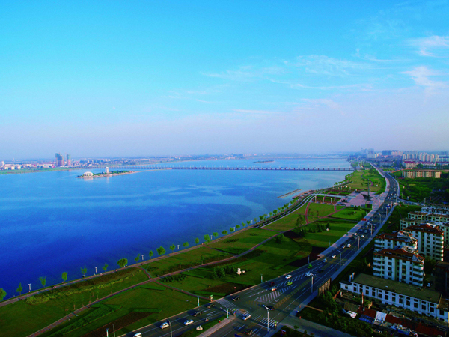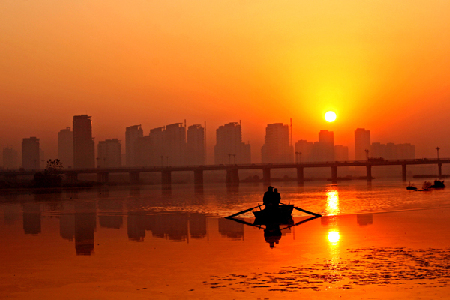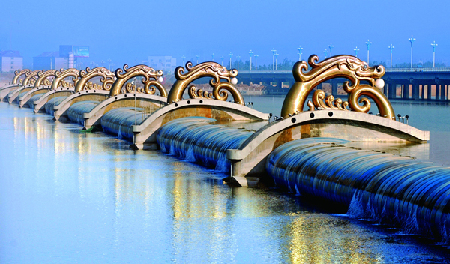Linyi
(chinadaily.com.cn)| Updated : 2023-01-10
Print PrintLinyi is located at the southeast of Shandong province, facing the Yellow Sea to the east and bordering Jiangsu province in the south.
Exercising jurisdiction over nine counties and three districts, with a total area of 17,191.2 square kilometers, it is the largest administrative division of the whole province in terms of area and population.
Linyi is known for the many titles it has obtained, such as National Double-Support Model City, Outstanding Tourist City of China, National Environmental Protection Model City, City of Geothermal Resources of China, City of Calligraphy of China, and City of Markets of China.

[Photo provided to chinadaily.com.cn]
With a 2500-year history, Linyi is also a historic city. The famous Bamboo Slips of Sun Zi's "Art of War" and Sun Bin's "Art of War" were excavated there. Thirteen of the 72 good disciples of Confucius grew up in Linyi.
The city is home to the Former Residence of Wang Xizhi, the grand master and founder of Cao Shu of the Eastern Jin Dynasty and the Memorial Hall of Zhuge Liang, the strategist of the Three Kingdoms Period. The outstanding calligrapher Yan Zhenqing of the Tang Dynasty and the prominent mathematician of the Eastern Han Dynasty who invented abacus arithmetic also grew up or once lived there.

[Photo provided to chinadaily.com.cn]
Additionally, Linyi is a famous revolutionary base area. During the period of the Anti-Japanese War and the War of Liberation, the Chinese Communist Party built a revolutionary base in the area of Binghai, in central and Southern Shandong province, where many proletarian revolutionaries of the older generation made their contributions to Chinese revolutionary history, among them Liu Shaoqi, Chen Yi, Luo Ronghuan, Xu Xiangqian and Su Yu.
The revolutionary base had a population of 4.2 million during the war. Two hundred thousand of them joined the army and entered the war, more than 1 million supported the army and the front, and more than 100,000 died.
A group of advanced model figures emerged in Linyi, such as Ming Deying, a remarkable countrywoman who saved the wounded soldiers with her milk, and six other remarkable women who made great contributions to the army and the front.

[Photo provided to chinadaily.com.cn]
Linyi abounds in natural resources. It has abundant fresh water in a volume of 5.54 billion cubic m, or one-sixth of the total volume of the whole province.
More than 90,000 water conservancy projects have been established, 37 of which are large-scale and medium-scale reservoirs with a total capacity of 3.41 billion cubic m.
Linyi possesses a great variety of mineral resources. There are 82 types of minerals with proven reserves. The diamond reserves rank second in China and the reserves of quartz sandstone, ceramic clay, dolomite and granite are in the top position in Shandong province.
Linyi's agricultural products and by-products are of great quantity and quality. The city has 8 production bases with local characteristics of peanuts, tobacco, silkworm, wicker, ginkgo, honeysuckle, chestnut and tea.
Vegetable and fruit production are competitive industries in Linyi and the output of dehydrated vegetables has led the country in the past several years.

[Photo provided to chinadaily.com.cn]
Tourism resources of Linyi have distinctive local features. It has one 5A-level tourist attraction, and the number of tourist area graded 4A has reached 22; there are also three grade 3A attractions.
As the second highest peak in Shandong province, the main peak of Mengshan Mountain rises to a height of 1,156 m above sea-level and is known as a natural oxygen bar, a mountain resort of longevity and the second Mount Tai. The entire scenic spot is graded 4A.
The outline of Tianfo Mountain, extending for 3,800 m in Junan County, is like the figure of Buddha and is thus regarded as a wonder of the world. Hailed as the top drift gorge in an underground river, the underground grand gorge extends for 6,100 m in Yishui Country.
The Xiaobudong Rubber Dam on Yi River, with a total length of 1,247 m, is listed in the Guinness World Records as the longest rubber dam in the world.
Other places of historic interest or scenic beauty in Linyi enjoy great reputations in the province and indeed the country; for instance, Yinqueshan Museum of Bamboo Slips from the Han Tombs, the Former Residence of Wang Xizhi, the Memorial of the Meng-Liang-Gu Battle and the Shandong Tianyu Museum of Natural History in Pingyi County.

[Photo provided to chinadaily.com.cn]
Linyi is also a commercial city with a prosperous logistics industry. It has become an intensive and well-organized modern logistic distribution center. The city has formed the attitude of "Linyi in the north is equal to Yiwu in the south".
Making use of its advantageous commercial trade and logistics industry, Linyi implemented the strategy of reviving industry with commerce and lengthened the industry chain of processing, having first established eight highly competitive pillar industries in the areas of machinery, building materials, food, wood, medicine, chemicals, textiles and metallurgy.
Due to geographic advantages, Linyi is a transportation hub. It is located on the double intersection of the Rizhao-Dongping Expressway and the Beijing-Shanghai Expressway as well as the Jiaozhou-Xinyi Railway and the Yanzhou-Shijiusuo Port Railway. Its highway traffic kilometerage totals 20,000, among the most dense in the province.
Linyi is 100 kilometers from Rizhao, Lanshan and Lianyungang ports, and 200 kilometers from Qingdao Port. Its airport is of national grade 2 and has many connections to various cities. A three-dimensional transportation pattern has been formed.
